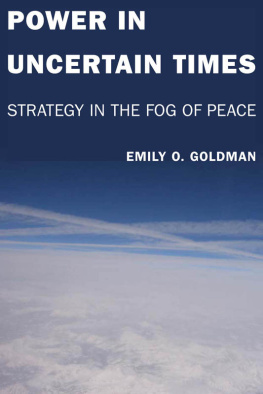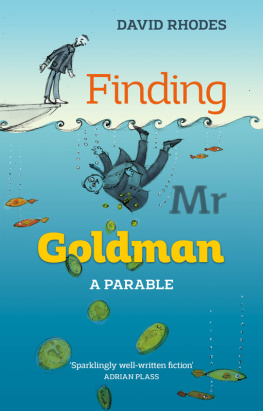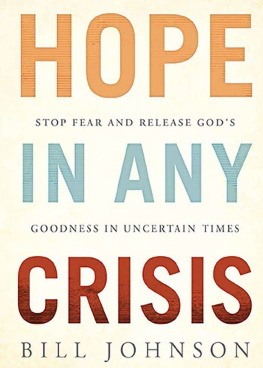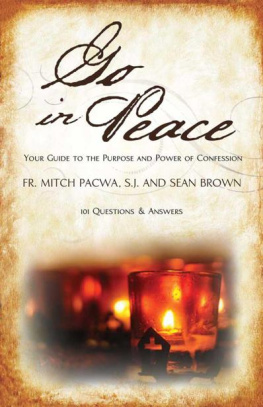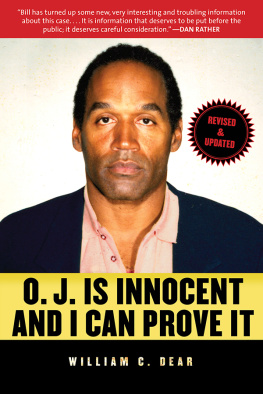Stanford University Press
Stanford, California
2011 by the Board of Trustees of the Leland Stanford Junior University.
All rights reserved.
No part of this book may be reproduced or transmitted in any form or by any means, electronic or mechanical, including photocopying and recording, or in any information storage or retrieval system without the prior written permission of Stanford University Press.
Special discounts for bulk quantities of Stanford Security Studies are available to corporations, professional associations, and other organizations. For details and discount information, contact the special sales department of Stanford University Press. Tel: (650) 736-1782, Fax: (650) 736-1784
Printed in the United States of America on acid-free, archival-quality paper
Library of Congress Cataloging-in-Publication Data
Goldman, Emily O.
Power in uncertain times : strategy in the fog of peace / Emily O. Goldman.
p. cm.
Includes bibliographical references and index.
ISBN 978-0-8047-5726-3 (cloth : alk. paper)
ISBN 978-0-8047-7433-8 (pbk. : alk. paper)
1. Military policyHistory. 2. National securityHistory. 3. StrategyHistory. 4. United StatesMilitary policy. 5. National securityUnited StatesHistory. I. Title.
UA11.G66 2011
355.033573dc22
2010011330
Typeset by Thompson Type in 10/14 Minion.
ISBN: 978-0-8047-7735-3 (electronic)
I dedicate this book to Alex, Catherine, and JR.
LIST OF FIGURES AND TABLES
Figures
Tables
PREFACE
THE GREATEST DIFFICULTY of military statecraft is that decisions must deal with future uncertain contingencies. What opponents may have to be faced, with what allies, and under what circumstances? What sorts of conflicts are most likely to arise? Planning for the future is by nature beset with uncertainty, whether one is making long-term projections, monitoring emerging problems, or warning of imminent danger. Defense planners have performed most poorly when making long-term projections. Yet long-range strategic planning is the problem confronting U.S. leaders today, and the stakes are high.
The current period is more uncertain than the Cold War past, but it also presents a window of opportunity for the United States to shape the future. Some strategies take advantage of windows of opportunity to create more favorable futures; others do not. The challenge for the United States, and for all states, is not just to manage uncertainty but to prevail in spite of it.
This book examines strategic choices in uncertain times and analyzes how different strategies position states to compete in the present and future, manage risk, and prevail despite uncertainty. The empirical chapters investigate how past and current political and military leaders have responded to uncertain strategic and technological environments and assess the consequences of those strategies for their states power and influence. Underestimating uncertainty and not thinking strategically about the future leave states ill prepared to meet future competitors. They may also miss the opportunities that uncertainty provides. Hegemons typically invest in sustaining capabilities and processes that support their power. Rising challengers leverage disruptive capabilities and processes that precipitate the decline of the leader.
Aware of this more than any other past hegemon, the postCold War United States tried to avoid this trap and sustain the nations hegemonic position by out-innovating any potential challengers, be they states or nonstate actors, and by shaping the global security environment. U.S. leaders have struggled to proactively shape the security environment over the medium and long-term, rather than just defensively react to events. The question is whether that path has a chance of forestalling hegemonic decline, enhancing U.S. security, and creating a more favorable international environment for the future.
It is but a slight exaggeration to say that I have been writing this book for almost twenty years. I have many people to thank. The first person is Mackubin Owens, who planted the idea for this book in my mind when I was a visiting professor at the U.S. Naval War College in 19911992. The first Gulf War had ended. National security practitioners were debating how to characterize the new era. Military educational institutions were reworking their curricula to make it more relevant to the postCold War period. One day Mac referred to the fog of peace when describing the uncertainty and lack of strategic anchor characterizing the current period. This was an idea I knew I had to explore. There was no theory of strategy for times when threats were uncertain.
I benefited from the advice and support of Larry Berman, Chris Demchak, Colin Elman, Theo Farrell, Chaim Kaufman, Miko Nincic, and Andy Ross. A particular debt of gratitude goes to Nick Lambert, who patiently discussed my thesis and the evidence over many sessions. I was immensely fortunate to have several superb research assistants: Leo Blanken, Olga Bogatyrenko, Phillip Khan, and John Turpin.
Over the years I received generous financial support from the University of Californias Institute on Global Conflict and Cooperation, the Smith Richardson Foundation, and the Woodrow Wilson International Center for Scholars. The editors at Stanford University Press have been both enthusiastic and patient while I completed the manuscript.
I am convinced that the subject of this book is as relevant today as it was twenty years ago. I am equally convinced that while I and a few others may have started a more considered conversation about the fog of peace, that conversation will notand should notend. I hope I spur others to study this subject, develop and test theory about it, and inform policy as well as academic debates about strategic choice in uncertain times.
Three individuals have been personal inspirations to me. My son Alex Forrest inspired me with the daily commitment and intellectual focus he demonstrated as he prepared for his Bar Mitzvah. My daughter Catherine Forrestthe only girl on her tackle football team, one of two girls on her ice hockey team, and now both a wrestler and boxercontinually inspires me with her determination, strength of character, and spirit. JR Vines has believed in me more than anyone and taught me to believe in myself.
1 THE FOG OF PEACE
THE UNITED STATES faces a bewildering array of strategic challenges today. The wars in Iraq and Afghanistan have dominated headlines in recent years, but the problems posed by North Korea, nuclear Iran, rising China, resurgent Russia, and spreading violent extremism vie for attention and resources. The perceptual reference points and decision frameworks that guided national security decision making since the mid-twentieth century are no longer meaningful in todays world. The strategic environment has been characterized in national security documents and debates over the past decade as uncertain and chaotic. A more accurate descriptor is complex. There is no dominant threat, no single strategic challenger, no clear enemy. Relative to the Cold War context that forged and honed our strategic constructs, we now confront a greater number of threats, greater diversity in the types of security actors that can threaten our interests, and a more interdependent world in which rapidly emerging technologies quickly diffuse and are exploited by others in unanticipated ways.
Geopolitical developments had already overturned Cold War givens before the terrorist attacks of September 11, 2001. Ethnic and religious extremists threatened peace. Nonstate actors, newly empowered by globalization and the information revolution, threatened to disrupt the information systems and critical infrastructure that undergird modern society. Proliferation of nuclear, biological, and chemical weapons technologies and expertise were diffusing the capability to cause massive damage and eroding prevailing international norms constraining the spread of weapons of mass destruction. Technological advances associated with an information technology revolution were, Complexity exacerbates these normal difficulties because resources must be allocated, personnel must be trained, and plans must be forged in the absence of a strategic rival.

